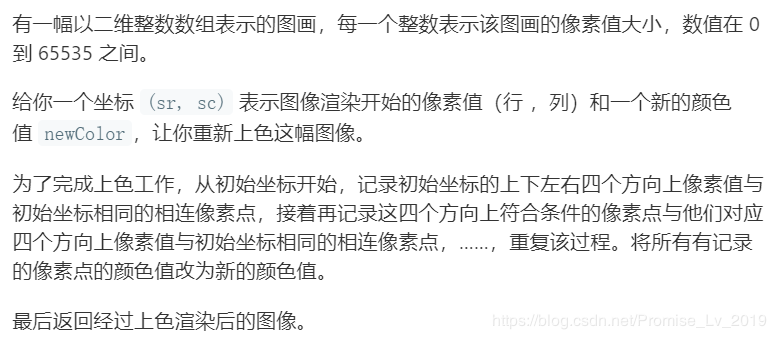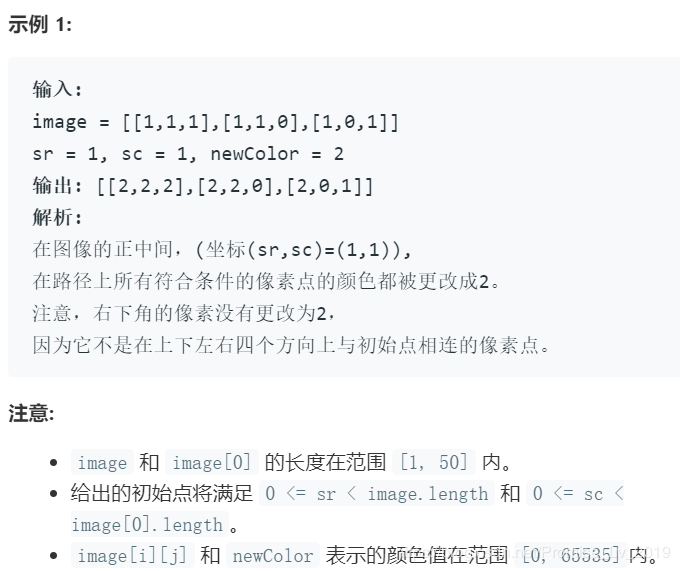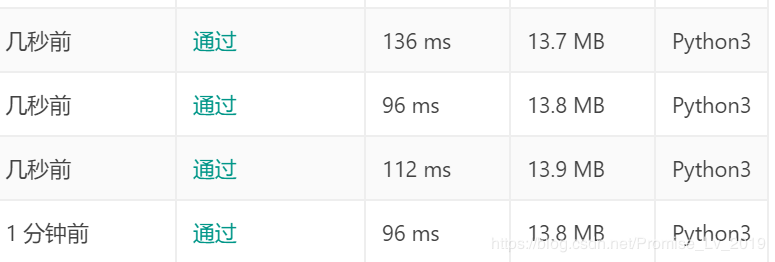Leetcode 刷题 (19):堆栈和队列应用:图像渲染(简单版的数岛屿)
733.
图像渲染
作者:吕诺


难度:简单
题目分析:这道题是容易版的数岛屿(数岛屿详细解析戳这里传送门)。简单的地方在于,对于岛屿题目,我们是不清楚“1” 会出现在什么地方,所以需要构建一个双层循环,遍历矩阵每一个点;而这道题,直接给了起点,所以我们把周围一片找出来即可。
class Solution:
def floodFill(self, image: List[List[int]], sr: int, sc: int, newColor: int) -> List[List[int]]:
# 这道题简单,dfs或是bfs都可以
# 动态规划呢?
# 先用递归的bfs
# sr,sc 是问题的起点,省去了一个大的遍历
# 找到目标点,上色,相当于标记了探索过的方向
row = len(image)
if row == 0:
return image
col = len(image[0])
old = image[sr][sc]
if old == newColor:
return image
# my_stack = [(sr, sc)]
dirs = ((0, 1), (1, 0), (0, -1), (-1, 0))
def dfs(image, i, j):
for k in range(4):
nxt_i, nxt_j = i + dirs[k][0], j + dirs[k][1]
if nxt_i >= 0 and nxt_i = 0 and nxt_j < col:
if image[nxt_i][nxt_j] == old:
image[nxt_i][nxt_j] = newColor
dfs(image, nxt_i, nxt_j)
image[sr][sc] = newColor
dfs(image, sr, sc)
return image
1.1 运行效果:


一开始运行,出现了递归超过深度???最后排查了有两个错误导致!
我没有先把起点的颜色给改了……于是,可能导致各种嵌套(因为没改起点的值,到达其他的点时,有可能把起点重新加入探索,中间可能会很复杂),最后造成递归超过栈的深度 更新矩阵元素的时候,我把 image[nxt_i][nxt_j] 写成了 image[nxt_j][nxt_j]……对于这二个错误,写代码的时候细心点就可以了。第一个错误则要着重强调,不管对于深度优先探索DFS还是广度优先探索DFS,经过的点,一定要先标记,这样才能避免重复的探索。
最后还有一个要强调的,题目还要考虑新标的颜色跟原来一样的情况,这种情况,意味着矩阵不用修改,直接返回就好;如果没有判断,程序依然会溢出。
2. 解法二:深度优先搜索,非递归解法class Solution:
def floodFill(self, image: List[List[int]], sr: int, sc: int, newColor: int) -> List[List[int]]:
# 这道题简单,dfs或是bfs都可以
# 动态规划呢?
# 先用递归的bfs
# sr,sc 是问题的起点,省去了一个大的遍历
# 找到目标点,上色,相当于标记了探索过的方向
row = len(image)
if row == 0:
return image
col = len(image[0])
old = image[sr][sc]
if old == newColor:
return image
# my_stack = [(sr, sc)]
dirs = ((0, 1), (1, 0), (0, -1), (-1, 0))
# 我们自己维护栈
image[sr][sc] = newColor # 标记探索过
my_stack = [((sr,sc), 0)] # 起点进栈,还有待探索方向
while my_stack:
cur, index = my_stack.pop()
for i in range(index, 4):
nxt = cur[0] + dirs[i][0], cur[1] + dirs[i][1] # 下一个方向
if nxt[0]>= 0 and nxt[0] =0 and nxt[1] < col:
if image[nxt[0]][nxt[1]] == old: # 下一个方向符合
image[nxt[0]][nxt[1]] = newColor # 标颜色
my_stack.append((cur, i+1))
my_stack.append((nxt, 0))
break
return image
2.1 运行结果:


很奇怪,可能因为是晚上八点多提交,速度慢得可怕。但二者本质上没有区别。
这段时间做的是栈和队列的专题,写了很多使用DFS的代码,我目前受我看的教科书(裘宗燕的《数据结构与算法(Python语言描述)》)影响挺大的,比如栈每个位置保存两个信息,一个是待探索点,一个是开始方向;这其实很接近我们编写递归算法解释器函数帧存放的数据。
在教科书中,这种解法对于求解迷宫有一个非常大的好处,只要我们逐一输出栈,就能得到一条从起点到终点的路。另外一个好处,可能是每一步,待探索方向很多的时候,可以节省保存空间吧。
由于考虑到探索方向并无先后之分,下面尝试把所有方向统一入栈,然后弹出最后一个入栈方向探索。
2.3 尝试另外的DFS写法:class Solution:
def floodFill(self, image: List[List[int]], sr: int, sc: int, newColor: int) -> List[List[int]]:
# 这道题简单,dfs或是bfs都可以
# 动态规划呢?
# 先用递归的bfs
# sr,sc 是问题的起点,省去了一个大的遍历
# 找到目标点,上色,相当于标记了探索过的方向
row = len(image)
if row == 0:
return image
col = len(image[0])
old = image[sr][sc]
if old == newColor:
return image
# my_stack = [(sr, sc)]
dirs = ((0, 1), (1, 0), (0, -1), (-1, 0))
# 采用新的DFS的写法
image[sr][sc] = newColor # 标记探索过
my_stack = [(sr,sc)] # 起点进栈,还有待探索方向
while my_stack:
cur = my_stack.pop()
for i in range(4):
nxt = cur[0] + dirs[i][0], cur[1] + dirs[i][1] # 下一个方向
if nxt[0]>= 0 and nxt[0] =0 and nxt[1] < col:
if image[nxt[0]][nxt[1]] == old: # 下一个方向符合
image[nxt[0]][nxt[1]] = newColor # 标颜色
my_stack.append(nxt)
return image
2.3.1 运行结果:


一开始速度很快,后来两次不知道怎么就又慢了……
class Solution:
def floodFill(self, image: List[List[int]], sr: int, sc: int, newColor: int) -> List[List[int]]:
# 这道题简单,dfs或是bfs都可以
# 动态规划呢?
# 先用递归的bfs
# sr,sc 是问题的起点,省去了一个大的遍历
# 找到目标点,上色,相当于标记了探索过的方向
row = len(image)
if row == 0:
return image
col = len(image[0])
old = image[sr][sc]
if old == newColor:
return image
# my_stack = [(sr, sc)]
dirs = ((0, 1), (1, 0), (0, -1), (-1, 0))
# 广度优先搜索,BFS,跟新的DFS很像,只是出栈的顺序不一样
from collections import deque
my_que = deque()
image[sr][sc] = newColor # 标记探索过
my_que.append((sr,sc))
while my_que:
cur = my_que.popleft()
for i in range(4):
nxt = cur[0] + dirs[i][0], cur[1] + dirs[i][1] # 下一个方向
if nxt[0]>= 0 and nxt[0] =0 and nxt[1] < col:
if image[nxt[0]][nxt[1]] == old: # 下一个方向符合
image[nxt[0]][nxt[1]] = newColor # 标颜色
my_que.append(nxt)
return image
3.1 运行结果:


速度差不多,不做评论。
对于栈和队列,多做习题,很快就能掌握,因为代码的结构非常固定。
参考了Leetcode别人的答案,这道题还可以使用并查集,以后再补上。
作者:吕诺